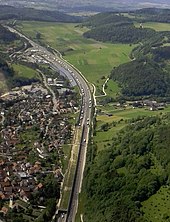Enclosure
Enclosures (singular: enclosure or housing ) are the complete or extensive conversion of disruptive emission sources or against hazards from the surrounding area. They can refer to stationary machines, production plants or traffic routes.
Housings for machines and production (for example, sound insulation cabins ) serve the health of the employees or the production costs by materials raumnah in the production process are kept. By means of an enclosure, diffuse emissions can be reduced.
Traffic route containment



If a traffic route crosses or touches an area that is particularly worthy of protection (residential development, recreation area, etc.), structural measures for (vertical) shielding from noise ( road traffic noise or rail traffic noise ) and exhaust gas may be necessary. For this purpose and noise barriers not when buildings, for example (vertical stray noise) or high buildings from the hillside far are above a noise barrier directly at said traffic route.
If the traffic route is arranged below the surface of the earth or water in order to dampen emissions , then this is known as a tunnel. In the other cases, for example, the term enclosure or gallery is used, which in DIN 1076 are considered tunnel structures from a length of 80 meters.
Depending on the structural design, there are also partial enclosures that are open to a side that is considered less worthy of protection. Examples can be found in Hamburg along the federal highway 433 between Fuhlsbüttel Airport and the Kronstiegtunnel or in Frankfurt on the federal highway 661 between the connections Ratsweg and Friedberger Landstrasse (Galerie Seckbacher Landstrasse). These partial enclosures can be called noise protection gallery structures or galleries for short. As a lightweight construction, the protective structure can only be designed for snow loads. In some cases, ventilation can also be freely upwards using noise protection grids.
The transition from the definition of housing to the definition of tunnel is fluid, as it is not always possible to recognize the background of the structural measure in the city or landscape. This can have a cosmetic (then limited) use in the cityscape, e.g. B. the shift of car traffic out of the general field of vision (enclosure), or indispensable (then unconditional) benefits such as the creation of a new traffic route through or below a natural obstacle, e.g. B. a mountain or a river (tunnel).
Examples: The Rheinufer tunnels in Düsseldorf and Cologne are tunnel structures because they were constructed using the cut-and-cover method, are located below the general level of the surrounding terrain and were covered with earth after their construction. Their main purpose is noise protection. The Elbtunnel in Hamburg or the Warnowtunnel in Rostock (beneath natural obstacles) are structurally (constructive) tunnels, which were created in a mining manner (drilling or blasting).
Another example north of Hamburg's Elbe Tunnel: Here, the Hamburg Senate recently decided to enclose Autobahn 7 in the form of a structure commonly known as the Hamburg cover . The cover is to be created between the Othmarscher end of the tunnel and the HH-Volkspark junction. Since it was built in the 1970s, the A 7 has been routed along this route in a cut (below the terrain level); the cover will structurally lengthen the Elbe tunnel as an enclosure. The background to this lies in the noise and emissions reduction sought for the Autobahn 7 between the Hamburg-Othmarschen junctions (northern end of the tunnel) and Hamburg-Volkspark.
The enclosures also include the rockfall protection galleries and avalanche galleries, which have been tried and tested for decades . Due to their mostly exposed hillside location and the higher load profile, they are more expensive.
Problems and expenses
The tunnel-like construction of an all-round housing creates additional expenditure for lighting and ventilation. Furthermore, escape routes and fire protection must be observed. The costs for construction and operation are therefore considerably higher than for a noise barrier.
Examples
- Bovender lid
- Enclosure Lobeda , Jena
- Housing Dalheim , Wetzlar
- Enclosure Schwamendingen , Zurich
- Weimarer Strasse tunnel , Fulda
Web links
Individual evidence
- ^ Franz Joseph Dreyhaupt (ed.): VDI-Lexikon Umwelttechnik. VDI-Verlag, Düsseldorf 1994, ISBN 3-18-400891-6 , p. 413.
- ↑ DIN 1076: 1999-11: Engineering structures in the course of roads and paths . Paragraph 3 Terms

